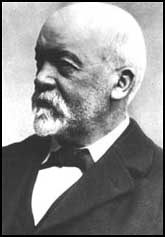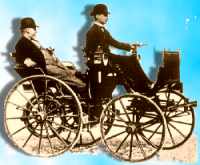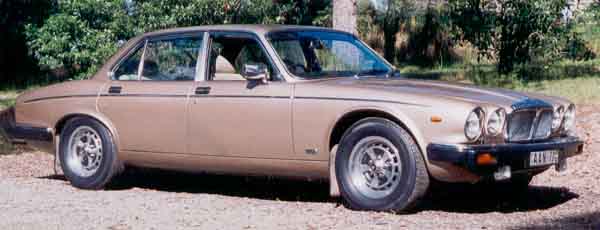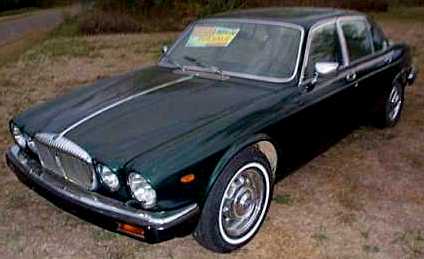|
|||||||||||||||||||||||||||||||||||||||
|
In 1885, Gottlieb Daimler (together with his design partner Wilhelm Maybach) took Nicolaus Otto's internal combustion engine a step further and patented what is generally recognized as the prototype of the modern gas engine. Daimler's connection to Otto was a direct one; Daimler worked as technical director of Deutz Gasmotorenfabrik, which Nikolaus Otto co-owned in 1872. There is some controversy as to who built the first motorcycle Otto or Daimler.
Gottlieb
Daimler was born in Struttgart in 1834. After studying at the Struttgart
Polytechnic he travelled to Manchester where he worked with Joseph
Whitworth.
The 1885 Daimler - Maybach engine was small, lightweight, fast, used a gasoline-injected carburetor, and had a vertical cylinder. The size, speed, and efficiency of the engine allowed for a revolution in car design. On March 8, 1886, Daimler took a stagecoach (made by Wilhelm Wimpff & Sohn) and adapted it to hold his engine, thereby designing the world's first four-wheeled automobile.
The Daimler Motoren Gesellschaft was founded in 1890 and four years later a Daimler-powered car won the Paris to Rouen, the world's first international car race. Gottlieb Daimler died in 1891.
In 1889, Daimler invented a V-slanted two cylinder, four-stroke engine with mushroom-shaped valves. Just like Otto's 1876 engine, Daimler's new engine set the basis for all car engines going forward. Also in 1889, Daimler and Maybach built their first automobile from the ground up, they did not adapt another purpose vehicle as had always been done previously. The new Daimler automobile had a four-speed transmission and obtained speeds of 10 mph.
Daimler founded the Daimler Motoren-Gesellschaft in 1890 to manufacture his designs. Eleven years later, Wilhelm Maybach designed the Mercedes. A few years later left Maybach left Daimler to set up his own factory for making engines for Zeppelin airships. In 1894, the first automobile race in the world was won by a car with a Daimler engine. Daimler was a workaholic who made the automotive revolution possible.
To avoid confusion and licensing troubles, the name Mercedes was adopted for the cars built by Daimler itself in the early 1900s, while the name Daimler was last used for a German built car in 1908.
Daimler
Double Six - For Sale in Sussex - Offers Around £3,500
The 1989 example we are offering is in exceptional condition - the original classic shape. Finished in silver metallic with black leather upholstery. Service history. Stereo. LPG conversion for economy with flick of the switch changeover (which can be removed. Comfortable fast luxury motoring. A bit of old England and a very nice drive.
Guide Price £3,500 Location: Eastbourne in Sussex
For every policy sold through the link above Hastings Direct make a contribution to the running of this website. Why not save money on your insurance and help us at the same time? Thank you for your help.
Daimler Chrysler
In 1924, "Daimler Motor Company" merged with Benz to form the Daimler-Benz car company which built Mercedes-Benz cars and trucks. In 1998 Daimler-Benz took over Chrysler to form DaimlerChrysler. British
The UK patent rights to the Gottlieb Daimler's engine were purchased in 1893 by Frederick Simms, who formed a new English company. This took the name of the "Daimler Motor Syndicate". In 1896 Simms and Harry Lawson moved into car production in the city of Coventry as the "Daimler Motor Company". From 1910 it was controlled by the Birmingham BSA company, producing military vehicles as well as cars. The distinguishing mark of the British Daimler was that the radiator cowling shells had a series of scallops on the top edge. Daimler produced a variety of cars, before becoming an upmarket (badge-engineered) version of the Jaguar. Jaguar (and British Leyland)
In 1960 the Daimler name was sold to Jaguar. In a classic case of badge engineering the name was subsequently used for more luxurious Jaguar models, eg. Daimler Double Six Vanden Plas for a version of the XJ 12. Apart from the badge, these were distinguishable from the Jaguars by the scallops on the top edge of the grille. Less luxuriously, the UK Daimler company was also involved in bus production. In 1968, Jaguar became part of British Leyland, taking Daimler with it. This lasted until 1982.
Jaguar (Ford)
In 1989/1990 the Ford Motor Company acquired Jaguar and with it the right to use the Daimler name on a car. In 1992, Daimler stopped producing its model 250 limousine, the only model car it still produced that was not based upon a Jaguar. In 1996 Jaguar produced a "Daimler Century" model to celebrate 100 years of motoring. Despite the potential confusion with DaimlerChrysler, the name was still in use by Jaguar in the early twenty-first century.
Just eleven years after the launch of the E-type, Jaguar stunned the world with another car capable of nearly 150mph, only this time the car was a 4 door saloon. The new car, known as the XJ12, looked nearly identical to its six cylinder sister car, the XJ6, which must have surprised a few autobahn users. As with other models in the Jaguar/Daimler range an up-market Daimler version was also offered, the Double Six.
The name Double Six harks back to Daimler's heydays in the 1930's when its last V12 limousine model was also called the Double Six. The XJ12 and Double Six shared their new engine with the new V12 E-type and developed some 253bhp, unfortunately fuel consumption figures were alarmingly low even by Jaguar/Daimler standards.
The bodywork of this car is ageless. It is arguably the most beautiful coupe ever build by Jaguar/Daimler. This and the performance of the car is simply superb, even in today's traffic. It's a real gas guzzler but the joy of driving a cat that doesn't only purr but also GROWLS makes up for it.
1984 Daimler Double Six
In 1971 Jaguar announced its second post-war engine design, the new V12. The new engine broke much new ground for Jaguar and was fitted to the new Series 3 E-Type, later in 1972 it was also fitted to the new "super-saloons", the XJ12/Daimler Double Six.
The Jaguar V12 displaced 5343cc and featured overhead camshafts. In E-Type form the V12 produced 272bhp which was enough to propel the car way past the 150mph mark. Following the demise of the E-Type in 1975 the V12 engine lived on in the fuel injected XJS and continued in the XJ12 models right up until the XJ40 V12 in the late 80's.
The Daimler coupes are the most prized by serious collectors as they were only produced in such small numbers. In total only 1,677 Daimler Sovereign coupe were produced, and only 407 of the Daimler Double Six coupes. Interestingly, they were never shipped to the North American market, most of them went to the UK and European segments. A mere handful made their way down to Australia. In total only 2 Daimler Double Six coupes and 2 Daimler Sovereign coupes were imported by Jaguar Australia.
These numbers have been 'swelled' with the private importation of 6 Daimler Double Six coupes and 18 Daimler Sovereign coupes. To date we only know of 1 Daimler Sovereign coupe in South Africa and 2 of them in New Zealand. Germany seems to favour the big V12 's as there are 8 known Daimler Double Sixes there. If you know of any in your country, then please let us know.
Double Six interior
Basically, the Daimler double six is a badge engineered Jaguar Xj12. The extras over the Jag are the 'van den plas' trim, including incredible leather interior, no plastic backings here! The seats are like armchairs, even in the back (individual armchairs matching the front). You also get real leather door trims, with mahogany and boxwood inlay. Lovely. Remember these cars were £35000 new in the early 1980's. The mechanicals are Jaguar xj12, being a 5.3 V12 mated to GM three speed auto-box, and limited-slip-diff. The engine is perfectly balanced, and runs like a turbine, there is nothing quite like it. The car is so quiet at low revs, they fitted a device to prevent the car being started twice. A well serviced example will handle very well, it's incredible how a two tonne car can take corners like this and with relatively soft suspension.
Downhill wind behind you 155mph is possible, but that might just be an optimistic speedo! To own one you need either to be rich or to be a mechanic/welder yourself. The one major drawback is the 12-14 mpg if you are lucky.
The Daimler coupes had a few minor differences from their Jaguar counterparts, apart from the badging and fluted chrome. The Daimler coupes had their door cappings covered with black vinyl, rather than the matching colour to the rest of the interior. They also came with the chromed steel wheels rather than the painted variety. The Daimler Double Six Coupes also came with Chrome Waist Mouldings along the side of each car.
What is interesting about the Daimler XJC 's is that nowhere on the vehicle is there a badge or sign that says XJC ! The Jaguar XJC 's were badged XJ12C / XJ5.2C or XJ6C / XJ4.2C depending on which market they were sent to. The Daimler variants were only given a single name badge positioned on the left hand side of the rear number plate. True to period they were in the 'script' style popular at that time. Both these models also had the distinctive 'fluted' chrome adornments to the engine grill and rear number plate, which were characteristic of all the Daimler models. They also had the round Daimler 'D' script badging on the top of the grill and in the centre of the steering wheel.
The Daimler Sovereign coupe was the 6 cylinder / 4.2 litre model, and the Daimler Double Six coupe was the 12 cylinder / 5.3 litre model. What is interesting about the Daimler XJC 's is that nowhere on the vehicle is there a badge or sign that says XJC ! The Jaguar XJC 's were badged XJ12C / XJ5.2C or XJ6C / XJ4.2C depending on which market they were sent to. The Daimler variants were only given a single name badge positioned on thme. e left hand side of the rear number plate. True to period they were in the 'script' style popular at that time.
The Daimler coupes also had a few stand-alone print advertisements and brochures etc, but mostly they were addendums to Daimler Saloon advertising and or brochures. One of the cleverest was the set of several pics that was used in print ad campaigns of the seventies. The set of photographs depicted a chauffeur slowly uncovering a Daimler saloon car. The same principal was used on the Jaguar version.
DAIMLER DOUBLE 6 PRODUCTION 1974 1 1975 76 1976 149 1977 159 1978 22
ENGINE: Jaguar V12 OHC 5343cc 90mm x 70mm bore/stroke
Daimler Double 6 1981
LINKS:
The History of Daimler-Benz Timeline of the famous car manufacturer - Daimler.
The Website is sponsored by Solar Cola
|
|||||||||||||||||||||||||||||||||||||||
|
The
content of this website is copyright © and design copyright 1991 and
2007 Electrick Publications and NJK. All rights reserved. The bird |
|||||||||||||||||||||||||||||||||||||||
|
AUTOMOTIVE | EDUCATION | SOLAR CAR RACING TEAMS | SOLAR CAR RACING TEAMS | SOLAR CARS |
|||||||||||||||||||||||||||||||||||||||






